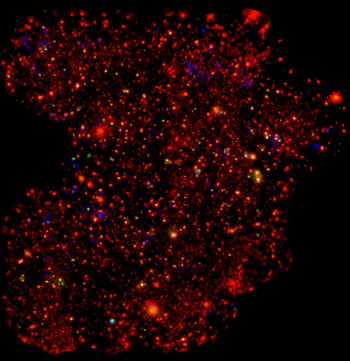Catholic author Solange Hertz, writing in support of Geocentrism, states that the opposing belief of Heliocentrism rests upon a false notion, because "it's impossible to see what's actually going on in outer space without standing outside the universe" (1). Without endorsing her thesis, this observation brings up an interesting searching question. If we were standing outside the universe, what would we see? We would be dazzled to view the interplanetary worlds, the interstellar movement, intergalactic groups, and deep space and time. With the help of modern technology, mankind has a good idea what comprises these four domains.

The space-based XMM telescope has detected over 2 million galaxies with its imagings |
The universe, says science author Giles Sparrow, "stretches at least 130 billion trillion kilometers [80 billion trillion miles] in every direction around us. We know that the magnificent vault of stars emblazoning Earth's night skies are an infinitesimal fraction of the hundreds of billions that exist in our galaxy, and we also know there are at least as many galaxies in the universe as there are stars in the Milky Way. We know our galaxy is a member of a cluster of galaxies, that is itself an outlying member of a super-cluster 100 million light years across, which is but part of a filament that stretches a billion light years across space" (2).
Other authors, Krisciunas and Yenne, comment that in order to study the universe "one must enter the realms of physics and metaphysics, or, more specifically, astronomy and theology" (3). I would add that especially the realms of metaphysics and theology must be entered. For without these aides, one could miss the point that this radiant, sparkling universe, this harmonious, jeweled canopy which houses the earth and its inhabitants, was created by an act of God's will.
Indeed, Venerable Mary of Agreda emphasizes the profound religious meaning of created things in the universe:

The lion's symbolic meaning is vigilance and bravery. Below, the serpent's forked tongue is a symbol of the lie
 |
"All God's works, and the disposition of them, as they were to be called into being, the Lord had in his mind ab initio [from the beginning], and He numbered and weighed them according to His equity and rectitude. He knew the constitution of the world before its creation, as it is written in the Book of Wisdom (7:18-20). He knew the beginning, the middle and the end of time, the changes of the years and the courses of the ages, the disposition of the stars, the powers of the elements, the nature of animals, the wrath of wild beasts, the force of winds, the difference of plants, the virtues of roots and the thoughts of men. All He weighed and counted (Wisdom 11:21), not only that which is literally true of the rational and irrational creatures, but He pre-ordained also all that which is signified by these creatures" (4)
Man with his immortal soul is at the center of this creation, his life existing for but a moment, "a gleam of light between two eternities." And in this moment, he has been given a primal purpose, to know, love and serve God. To seek God's kingdom first (Matt. 6: 33) is the principal goal of life, of every life since Adam and Eve. Everything else is secondary, tertiary, on down the line ad infinitum. So teaches the Catholic Church in her Scripture, Tradition and Magisterium.
But seeking God's kingdom first has rules. When phenomena are sought first, the order of inquiry is reversed. Scholasticism seeks the objective reality as its starting point: "The object of intelligence is the being" (5). On the contrary, Phenomenology seeks the way man interprets reality as its base: Phenomenology “takes consciousness as its starting point" (6). That is to say, subjectivism with its uncertainties enters the picture.
Perhaps the philosophy of John Paul II, which was Phenomenology, gives a clue to how the Church has plummeted into confusion. This is why in 1996, while attending a science convention, John Paul II stated, "New knowledge has led to the recognition of the theory of evolution as more than a hypothesis" (7). I stress that he is emphasizing the knowledge, the way man understands what he sees, not the objective reality he is seeing. Anyway, he takes a clear position in favor of evolution.

JPII: open door to evolution |
We are reminded here of the reprimand of Pope St. Pius X in Pascendi that evolution is the lodestar for a Modernist. Even though John Paul's statement refers specifically to the evolution of life, Pascendi had already pointed to the acceptation of evolution as a gambit. In the encyclical there are references to evolution of the idea of God (n. 17); evolution of the Church and the Sacraments (n. 20); evolution of doctrine (n. 26); evolution of history and philosophy (n. 35). It observes that according to the Modernist doctrine, "to the laws of evolution everything is subject – dogmas, Church, worship, the Books we revere as sacred, even the Faith itself" (n. 26). Further it says that for Modernists, "dogmas and their evolution are to be harmonized with science and history" (n. 38).
So, in accepting “scientific” evolution John Paul II seems to be opening doors to all the other types of evolution condemned by St. Pius X.
The name Progressivism comes from the main tendency of those of this current to adapt the Church to the progress of science, as did Modernism. Metaphysics, theology, the Magisterium, Tradition, Scripture, all must bow to science. Once evolution is accepted as a “scientific” imperative, anything goes.
Today we have many theories to explain the universe. Several of them pretend that it is subjected to a continuous evolution. For example, the theory of the Big Bang religiously supports evolution. Also the discussion of an Intelligent Design present in creation has many affinities with evolutionism.
I accentuate that these theories are only hypotheses; they do not have the evidence of objective reality. They are hypotheses trying to explain something that man did not grasp. Therefore, they are not scientific, properly speaking. They would be scientific if and when they turn out an indisputable result. Until then, they are speculations.
Even if such results were indisputably scientific, the researchers should be humble, because even great scientists admit of errors in their scientific calculations.

Heisenberg points to an element of uncertainty in scientific measurements |
That uncertainty exists in high science was demonstrated by Werner Heisenberg, the Nobel Prize winner in physics, awarded for his role in the creation of quantum mechanics. He set out what is known as the "uncertainty principle": "What the uncertainty principle does is to specify certain theoretical limits on our ability to make scientific measurements" (8).
By accepting the theories of modern man on evolution as necessarily correct, John Paul II suggests that there is no "uncertainty" about evolution. Even if evolution were an objective reality, which it is not, his affirmation is baseless and inappropriate. Unlike the late Pope, those honest words of Heisenberg contain the humble proposition that uncertainty exists in science. Such statements are a rarity today. We can find them only in those who are not concerned about spreading speculations as true science.
How could the previous occupant of St. Peter's Chair possibly present a simple theory such as evolution as an indisputable fact?
Perhaps the answer lies in Pascendi:
"A lamentable spectacle is that presented by the aberrations of human reason when it yields to the spirit of novelty, when against the warning of the Apostle, it seeks to know beyond what it is meant to know, and when relying too much on itself it thinks it can find the truth outside the Catholic Church wherein truth is found without the slightest shadow of error” (n. 49).
As one can see John Paul II followed the path of the Modernists, befitting to the entire agenda of Progressivism, a current of thought to which he belonged.
1. Solange Strong Hertz, The Sixth Trumpet, Minnesota: The Remnant Press, p. 8.
2. Giles Sparrow, Cosmos, London: Quercus, 2006.
3. Krisciunas and Yenne, The Pictorial Atlas of the Universe, Mallard Press, 1989
4. Mary of Agreda, The Mystical City of God, The Conception, p. 74.
5. Parente et al, Dictionary of Dogmatic Theology, Milwaukee: Bruce Pub., 1951, p. 291
6. John Young, Reasoning Things Out, TX: Stella Maris, 1982, p. 70.
7. John Paul II, Address to the Pontifical Academy of Sciences, October 22, 1996.
8. Michael H. Hart, Ranking of the Most Influential Persons in History, NJ: Citadel Press, 1987, p. 241, 242.

Posted on January 18, 2008

Related Articles of Interest
 The Swan’s Song of Galileo’s Myth The Swan’s Song of Galileo’s Myth
 The Middle Ages, a Forest Filled with Symbols The Middle Ages, a Forest Filled with Symbols
 The Symbol of the Sword The Symbol of the Sword
 Vice and Virtue Symbolized in Animals Vice and Virtue Symbolized in Animals
 Fr. Ratzinger: Evolution Is a Fait Accompli to which the Church Must Adapt Fr. Ratzinger: Evolution Is a Fait Accompli to which the Church Must Adapt
 Foreword: A Critical Examination of the Theology of Karl Rahner Foreword: A Critical Examination of the Theology of Karl Rahner
 The Same "Faith" in Evolution The Same "Faith" in Evolution
 The Perplexing Pontificate of John Paul II The Perplexing Pontificate of John Paul II

|